Every house in which I’ve lived has had its garden problems: too much shade, too much moisture, too much sun, too much heat. The key to overcoming these garden problems is plant selection.
Just as every one of us has unique personal tastes, every plant has conditions that promote its best growth, conditions it will tolerate, and conditions where it will surely die. Forcing a plant to live where it will surely die means the end result is disappointment. Plant selection is important.
The best ways to select plants involve researching which plants perform in shade. One of my favorite gardening web sites Dave’s Garden has the care and cultural requirements of many plants so you can see what will survive in your area (sun, shade, and hardiness zone). These are submitted by gardeners just like us so we’re getting people’s personal experiences (positive, neutral, and negative) and advice on overcoming problems.
Here are photos of some of my favorite plants for part shade to full shade. As they continue to grow and bloom, I will post more photos. Redbud (Cercis canadensis, below left) and Serviceberry (Amelanchier canadensis, below right) are two “understory” trees which means that they can handle growing in the shade of taller canopy trees. They generally stay shorter and they adapt well to part shade conditions. Both flower in the springtime. The Serviceberry blossoms have faded but it has begun to set fruit which will develop fall color in addition to the leaves which makes it multi-seasonal in its beauty.
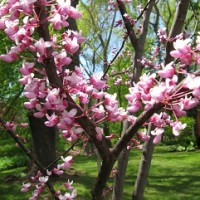

Among the evergreens that do well in shade, the Dwarf Alberta Spruce can handle significant shade, is slow growing, and is one of the few plants whose cold-hardy root systems can withstand being grown in a pot even through a Chicagoland winter. This Dwarf Albert Spruce (Picea glauca, below left) has been growing in a pot for 5 years. Their root systems are not large; their slow growth keeps them an ideal size for winter interest by the front door; and their new growth forms bright green “candles” that do not need trimming. Yews (Taxus, below right) come in upright and spreading forms. If you’re replacing some of these versatile foundation plantings, make sure of which type you have. I keep mine hand-trimmed to maintain a somewhat less formal look, but they respond well to mechanical trimmers.

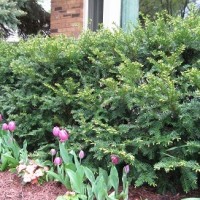
Here are some of my favorite flowers for shade. Deadnettle (Lamium, sp) comes in a variety of leaf forms and flower colors. This one (foreground below, left) is “Pink Pewter” and is followed by Vinca, Sweet Woodruff, Lily of the Valley and Ostrich fern. I have some blue lungwort whose flowers resemble bluebells, but this variety “Raspberry Splash” (pictured below) provides a nice color contrast to wood violets and pink columbine. Another fine feature is that deer don’t like any of these.
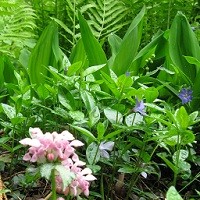
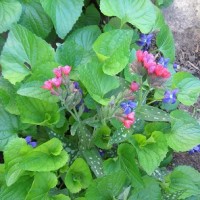
Likewise, bleedingheart (below, left) can handle shade and deer don’t like them. Astilbe, Aconitum (below, right) will be later to bloom and I spray my hostas with TreeGuard to keep the deer from devouring them.
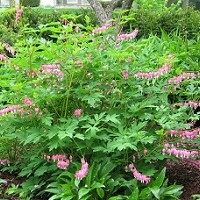
Why do some plants not tolerate shade?
It has to do with several plant characteristics. First, not all plants have the kind of capabilities in shady environments as shade-loving plants. Plants adapted to shady environments will often have (1) thinner leaves, (2) larger leaves, (3) more chlorophyll–the green pigment in leaves that helps with photosynthesis, and (4) these plants are more concerned with light harvesting than building leaf bulk. Sunny plants, on the other hand, build up protective mechanisms and structures within the leaves and will have a different ratio of pigments in order to protect themselves from the intensity of the sun.
Why is this important? For two reasons: (1) it means that some plants will never survive in sun or shade depending on its ability to adapt to the environment, and (2) it is important to allow seedlings grown indoors or plants grown in full sun to adapt—a process called acclimation or hardening-off (in the case of seedlings).
Have you ever taken tomato seedlings you’ve carefully pampered inside and brought them outdoors and they seemed to fry out in full sun? Tomatoes are supposed to have full sun, right? Yes. But they need time to adjust to the increased light conditions outdoors. So acclimating the seedlings gradually over a period of a week to 10 days will give them a chance to thicken their cuticles (waxy layer on leaves) and to structurally make changes to deal with wind, sun, rain, fluctuating temperatures, etc.
Of if you’ve ever bought a Ficus tree as a houseplant, brought it home, and it immediately dropped a lot of leaves, this is because it’s acclimating itself by putting off leaves that will be ineffective for your environment and putting on new leaves that will help the plant to survive in your home’s conditions.
Just as we were Created to BE Individuals, our understanding the individual characteristics of plants will help us to have a successful experience with garden and houseplants and demonstrate patience while our plants adjust to the changing seasons and their new environments.
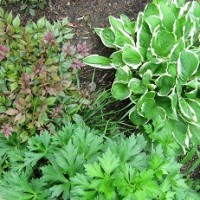
1 Comment
I have received a few questions about shade gardening and plant selection. Dave’s Garden, mentioned above, has a plant search which is free if you know the name of a plant. Subscribers can use the advanced search feature to custom-select plants for your particular locale.
There are other FREE resources in my area (Illinois) are:
The Cooperative Extension Service: http://urbanext.illinois.edu/perennials/specific.cfm
and the Chicago Botanic Garden:
http://www.bestplants.org/query_simple.htm
Most states have their versions of these. For example, Missouri has a Botanical Garden plant search feature:
http://www.mobot.org/gardeninghelp/plantfinder/Search.asp
Ohio State University Cooperative Extension service has plant fact sheets: http://extension.osu.edu/topics/garden/annuals-perennials-bulbs
The Cooperative Extension service is available in many states of the US since it fulfills the Land Grant requirements for these colleges.